How and where insulation is used for heating pipes
If you walk around the city in winter, you can see the thawed “tracks” of the heating mains. There is such a "heating" from poor-quality pipe insulation, because of which there is a huge loss of heat.
At the same time, homeowners on their own plots seek to protect them as much as possible using modern materials. Therefore, in the article we will deal with their types and show you what to look for when choosing.
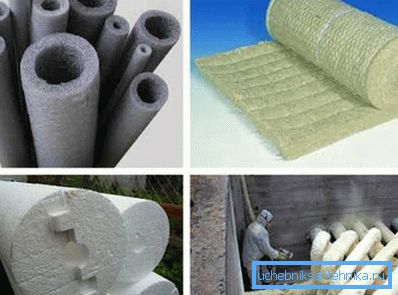
Why do you need it
Manipulations with warming will help not only significantly reduce the cost of space heating, but also increase the life of metal pipelines.
In the latter case, the material:
- will not allow condensation to form on the surface of products, which will eventually become a catalyst for corrosive processes;
- protects the coolant from freezing, which can also cause metal damage.
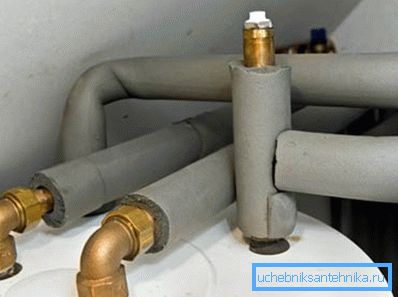
note
The climatic features of our country are such that it is necessary to isolate not only centralized trunk systems, but also domestic heating pipes.
When choosing insulation, consider the following:
- operating conditions of the heating system;
- heating temperature of the coolant;
- pipe diameter that affects the type of thermal insulation material.
Consider the last point in more detail:
- Soft rolls, rigid cylinders and semi-cylinders of the required shape are offered. The latter are used for pipelines of small diameters.
- The heat insulator of this type is supplied with grooves that facilitate and simplify the installation process.
- Also used for insulation segments of plastic materials and mineral wool.
- Hard insulation:
- resistant to high temperatures;
- has a low level of water absorption;
- does not change the strict geometric shape;
- able to provide additional protection against various mechanical damage.
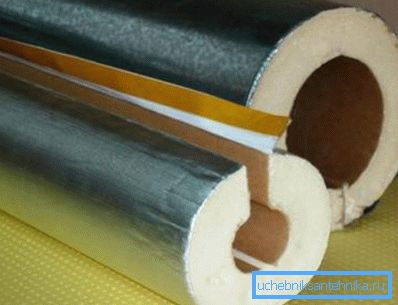
Kinds
Before deciding which heater to use for heating pipes, let's consider the main types of such materials and find out the areas of their use.
- Mineral or stone wool It is made of basalt rocks. Today it is one of the most sought-after heaters, due to its high efficiency.
There are such material advantages:
- the degree of heat resistance reaches 650? С, but, even when heated, it does not lose its initial thermal insulation and mechanical characteristics;
- resistance to chemical solvents, acids, oil solutions and alkalis;
- possesses insignificant water absorption, thanks to preliminary processing by special impregnating structures;
- non-toxic.
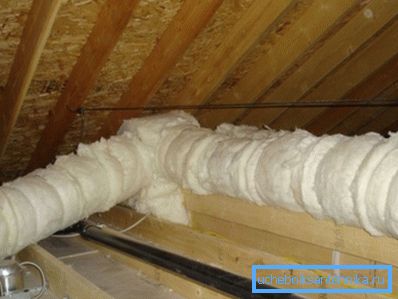
Tip: use insulation based on it for the insulation of pipes for heating and hot water, which are held in residential, industrial and public buildings. It can also be used for furnace chimneys.
- Glass wool or fiberglass Made from staple fiber, based on quartz sand, or glass breakage. This insulation is not as heat-resistant as stone, so its scope is somewhat narrower.
Release the material in rolls with a length of 1.55-2 m, sheet thickness - 3-4 microns. Glass wool has a low density, so the instruction recommends using it for pipelines that heat up to a temperature not exceeding 180? С.
Of the positive properties can be noted:
- material resistance to vibration;
- does not respond to biological and chemical exposure;
- long service life.
Tip: use insulation for the insulation of ground communications.
- Polyurethane foam has a low thermal conductivity, and therefore is also used for the insulation of heating pipes. The design of a rigid form, consists of edges and walls. The insulation casting under production conditions is produced by the “pipe in pipe” method, the second of its name is the heat insulating shell.

The material is durable and able to retain heat well. The lack of polymer insulation - high price.
Let's consider in more detail the advantages of polyurethane foam:
- non-toxic, has a neutral smell;
- resistant to decay;
- does not pose a danger to our body;
- it is durable, it allows to prevent possible pipeline breaks due to external mechanical effects;
- good dielectric;
- resistant to plasticizers, acids, solvents and alkalis;
- maintains different weather conditions that allows to use it in the open air.
- Polyethylene foam harmless to humans, environmentally friendly, not afraid of moisture and sudden fluctuations in temperature. Today it is in demand as a thermal insulation material. It is made in the form of a tube of different diameter, and for ease of putting it on the tube along its entire length, an incision is made.
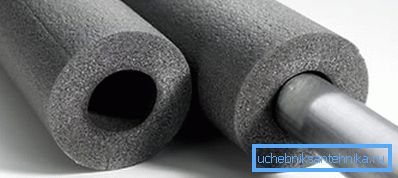
It is used for warming the risers for hot and cold water supply, as well as for heating. Does not lose its properties when interacting with building materials such as concrete, lime and the like.
Other insulation
| Styrofoam | Produce material in the form of 2 connecting halves using the “thorn-groove” method. This does not allow the formation of “cold bridges” in the heat insulating layer. |
| Styrofoam |
|
| Penoizol | It resembles the characteristics of the foam, only it is available in liquid form. It does not leave “gaps” on the surface when applied, and after drying it ensures the tightness of the system. |
| Foam glass | The safe material consisting of glass of cellular structure. Durable, non-shrink, non-flammable, resistant to chemical vapors and environments, not afraid of the invasion of rodents, durable in operation. Warming can be easily carried out by hand. |
| Thermal paint | Innovative domestic development. Its structure includes:
The thickness of the layer of 2 mm allows to achieve the same effect as when insulating with several layers of expanded polystyrene or mineral wool. Material:
They produce this insulation in the form of an aerosol, thereby maximally simplifying installation and allows the paint to get into the most hard-to-reach places. |
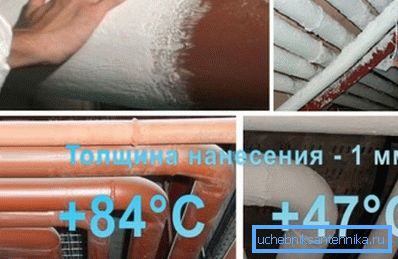
Conclusion
The use of heaters of different types makes it possible to significantly reduce heating costs, as well as protect pipelines from corrosion and mechanical stress. Today, familiar materials are used to everyone, as well as innovative - heat insulating paint (see also the article Outer diameter of pipes - everything you need to know about the dimensions).
In any case, the cost of purchasing materials and laying them on pipes will pay off very quickly. The video in the article will help you find additional information on this topic.